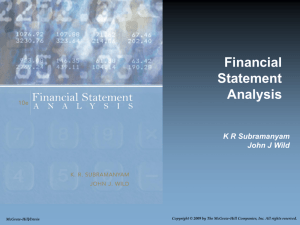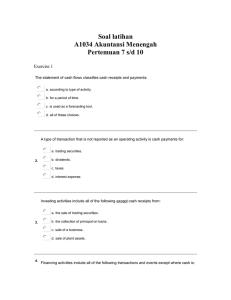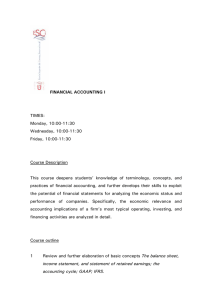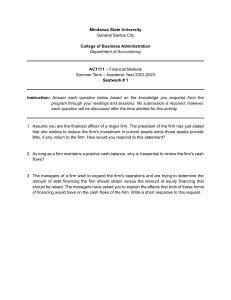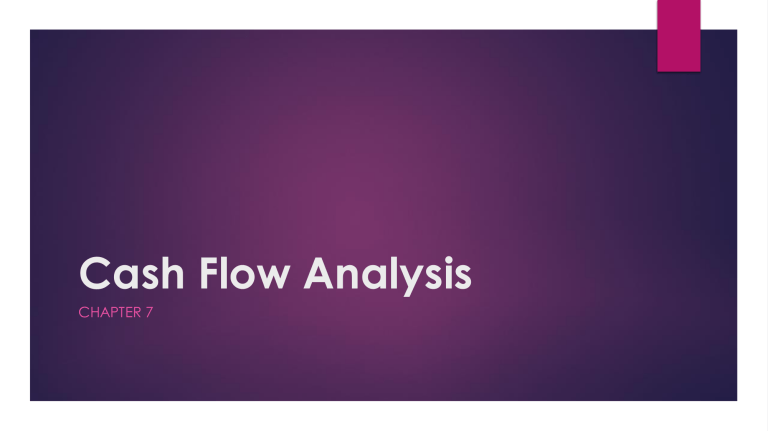
Cash Flow Analysis CHAPTER 7 Statement of Cash Flow RELEVANCE OF CASH Cash is the most liquid of assets . - offers a company both liquidity and flexibility. - It is both the beginning and the end of a company’s operating cycle. Contrast: Accrual accounting and Cash basis accounting. - Net cash flow as the end measure of profitability. - Cash flow analysis helps in assessing liquidity, solvency, and financial flexibility. Statement of Cash Flow RELEVANCE OF CASH Statement of cash flows (SCF) helps address questions such as: How much cash is generated from or used in operations? What expenditures are made with cash from operations? How are dividends paid when confronting an operating loss? What is the source of cash for debt payments? How is the increase in investments financed? What is the source of cash for new plant assets? Why is cash lower when income increased? What is the use of cash received from new financing? Statement of Cash Flow REPORTING BY ACTIVITIES The statement of cash flows reports cash receipt and cash payments by operating, financing, and investing activities-the primary business activities of a company. OPERATING ACTIVITIES are the earning-related activities of a company. Beyond revenue and expense activities represented in an income statement, they include the net inflows and outflows of cash resulting from related operating activities like extending credit to customers, investing in inventories, and obtaining credit from suppliers. Statement of Cash Flow REPORTING BY ACTIVITIES INVESTING ACTIVITIES are means of acquiring and disposing of noncash assets. - These activities involve assets expected to generate income for a company, such as purchases and sales of PPE and investment in securities. - Include lending funds and collecting the principal on these loans. FINANCING ACTIVITIES are means of contributing, withdrawing, and servicing funds to support business activities. - Include borrowing and repaying funds with bonds and other loans. - Include contributions and withdrawals by owners and their return on investment. Statement of Cash Flow CONSTRUCTING THE CASH FLOW STATEMENT INDIRECT METHOD - net income is adjusted for noncash income (expense) items and accruals to yield cash flows from operations. DIRECT METHOD - This method adjusts each income item for its related accruals and, arguably, provides a better format to assess the amount of operating cash inflows (outflows). - The format for computing net cash provided by investing and financing activities is the same for both methods. Only the preparation of net cash flows from operations differs. Statement Of Cash Flow PREPARATION OF THE CFS ( INDIRECT METHOD) Consider first the net cash from operations : Statement Of Cash Flow PREPARATION OF THE CFS ( INDIRECT METHOD) Depreciation and amortization add – back Statement Of Cash Flow INCOME V/S CASH FLOW - ( EXAMPLE) In the period of sale, net income is increased by $100, but no cash has been generated . Net income……….………………………………… $100 Depreciation and amortization expense……….. 0 Gains (losses) on sale of assets………………….. 0 Change in accounts receivable………………….. (100) Net cash flow from operations……………………. $ 0 In the following period, the receivable is collected and the statement of cash flows looks like this: Net income……….………………………………… $100 Depreciation and amortization expense………. 0 Gains (losses) on sale of assets………………….. 0 Change in accounts receivable………………….. 100 Net cash flow from operations……………………$ 0 Statement Of Cash Flow PREPARATION OF THE STATEMENT OF CASH FLOWS Adjustments for changes in balance sheet accounts can be summarized as follows: Account Increase Decrease ___________________________________________ Assets……….. Cash Outflow Cash inflow Liabilities……..Cash Inflow Cash Outflow _____________________________________________ Statement Of Cash Flow CONSTRUCTING THE STATEMENT 1. The company purchased a truck during the year at a cost of $30,000 that was financed in full by the manufacturer. 2. A truck with a cost of $10,000 and a net book value of $2,000 was sold during the year for $7,000. There were no other sales of depreciable assets. 3. Dividends paid during Year 2 are $51,000 Statement Of Cash Flow Statement Of Cash Flow DIRECT METHOD The direct (or inflow-outflow) method reports gross cash receipts and cash disbursements related to operations essentially adjusting each income statement item from accrual to cash basis -Reports total amounts of cash flowing in and out of a company -Preferred by analysts and creditors from operating activities -Implementation costs -When companies report using the direct method, they must disclose a reconciliation of net income to cash flows from operations (the indirect method) in a separate schedule Statement Of Cash Flow CONVERTING FROM INDIRECT TO DIRECT METHOD Analysis Implications of Cash Flows LIMITATIONS IN CASH FLOW REPORTING Some limitations of the current reporting of cash flow: -Practice does not require separate disclosure of cash flows pertaining to either extraordinary items or discontinued operations. -Interest and dividends received and interest paid are classified as operating cash flows. -Income taxes are classified as operating cash flows. -Removal of pretax (rather than after-tax) gains or losses on sale of plant or investments from operating activities distorts our analysis of both operating and investing activities. Analysis Implications of Cash Flows Analysis Implications of Cash Flows Analysis Implications of Cash Flows INTERPRETING CASH FLOWS AND NET INCOME An income statement records revenues when earned and expenses when incurred. - It does not show the timing of cash inflows and outflows, nor the effect of operations on liquidity and solvency. -This information is available in the Statement Cash Flow (SCF) Cash flows from operations (CFO) is a broader view of operating activities than is net income. - It is not a measure of profitability. Note: A net measure, be it net income or cash flows from operations, is of limited usefulness. The key is information about components of these net measures. Analysis Implications of Cash Flows INTERPRETING CASH FLOWS AND NET INCOME Accounting accruals determining net income rely on estimates, deferrals, allocations, and valuations. - Subjectively •Note: CFO effectively serve as a check on net income, but not a substitute for net income. CFO exclude elements of revenues and expenses not currently affecting cash. Our analysis of operations and profitability should not proceed without considering these elements. Analysis of Cash Flows In evaluating sources and uses of cash, the analyst should focus on questions like: Are asset replacements financed from internal or external funds? What are the financing sources of expansion and business acquisitions? Is the company dependent on external financing? What are the company’s investing demands and opportunities? What are the requirements and types of financing? Are managerial policies (such as dividends) highly sensitive to cash flows? Analysis of Cash Flows CASE ANALYSIS OF CASH FLOWS OF CAMPBELL SOUP Analysis of Cash Flows INFERENCES FROM ANALYSIS OF CASH FLOWS •Inferences from analysis of cash flows include: Where management committed its resources Where it reduced investments Where additional cash was derived from Where claims against the company were reduced Disposition of earnings and the investment of discretionary cash flows The size, composition, pattern, and stability of operating cash flows Analysis of Cash Flows ALTERNATIVE CASH FLOW MEASURES Net income plus depreciation and amortization - EBITDA (earnings before interest, taxes, depreciation, and amortization) Analysis of Cash Flows Issues with EBITDA The using up of long-term depreciable assets is a real expense that must not be ignored. The add-back of depreciation expense does not generate cash. It merely zeros out the noncash expense from net income as discussed above. Cash is provided by operating and financing activities, not by depreciation. Net income plus depreciation ignores changes in working capital accounts that comprise the remainder of net cash flows from operating activities. Yet changes in working capital accounts often comprise a large portion of cash flows from operating activities. Analysis of Cash Flows COMPANY AND ECONOMIC CONDITIONS While both successful and unsuccessful companies can experience problems with cash flows from operations, the reasons are markedly different. We must interpret changes in operating working capital items in light of economic circumstances. Inflationary conditions add to the financial burdens of companies and challenges for analysis. Analysis of Cash Flows FREE CASH FLOW Another definition that is widely used FCF =NOPAT - Change in NOA (net operating profits after tax (NOPAT) less the increase in net operating assets (NOA)) Analysis of Cash Flows FREE CASH FLOW Positive free cash flow reflects the amount available for business activities after allowances for financing and investing requirements to maintain productive capacity at current levels. Growth and financial flexibility depend on adequate free cash flow. Recognize that the amount of capital expenditures needed to maintain productive capacity is generally not disclosed instead, most use total capital expenditures, which is disclosed, but can include outlays for expansion of productive capacity. Analysis of Cash Flows CASH FLOW AS VALIDATORS The Statement Cash Flows is useful in identifying misleading or erroneous operating results or expectations. The Statement Cash Flow provides us with important clues on: Feasibility of financing capital expenditures. Cash sources in financing expansion. Dependence on external financing (liabilities versus equity). Future dividend policies. Ability in meeting debt service requirements. Financial flexibility to unanticipated needs and opportunities. Financial practices of management. Quality of earnings. Specialized Cash Flow Ratios Cash Flow Adequacy Ratio Measure of a company’s ability to generate sufficient cash from operations to cover capital expenditures, investments in inventories, and cash dividends: Three-year sum of cash from operations ______________________________________________________________________ Three-year sum of expenditures, Inventory additions, and cash dividends Cash Reinvestment Ratio Measure of the percentage of investment in assets representing operating cash retained and reinvested in the company for both replacing assets and growth in operations Operating cash flow – Dividends ______________________________________________________________________ Gross plant •Investment• Other assets •Working capital Thank you !!


